Chapter 1. Appendix D: Comparative Anatomy
Introduction
Biology is the study of life. One important aspect of biology is the understanding of organisms through dissection. This appendix includes procedures and pictures to aide you with dissections in lab.
Earthworm Dissection
1. Earthworm Dissection
Annelids are unique in that their bodies are segmented, a characteristic called metamerism. This feature evolved independently in annelids to facilitate burrowing. Earthworms move in a wavelike motion via peristalsis, due to contraction and relaxation of muscles in their body wall. They have circular and longitudinal muscles that facilitate crawling, burrowing and anchoring. In some annelids metamerism has evolved to facilitate undulatory swimming.
To casual observers, the earthworm is a simple ribbed tube pointed at both ends, with little obvious anatomical complexity yet earthworms are quite complex animals! They are bilaterally symmetrical, triploblastic organisms with organ systems in a true coelomate body plan. Furthermore, the adaptations that enable them to live and reproduce on land contrast with many of their closest relatives, which include other marine, freshwater and parasitic annelids, as well as mollusks!
Procedure
- Place an earthworm in 30% ethyl alcohol to anesthetize it. The worm is ready when it no longer exhibits a coiling response. This should take 10-15 minutes.
- Examine the external anatomy of the worm. Using the following figures, identify the anterior end of the worm by locating the prostomium, a small tapered projection over the mouth, and the clitellum, a swollen collar surrounding several segments of the anterior half of the worm.
- Under the dissecting microscope, between segments 12-15, try to locate the male gonopores through which sperm are released (note: the prostomium is not included in numbering segments).
- Rub the worm gently with a piece of paper towel, and peel off a small piece of the iridescent cuticle that covers the posterior end of the worm. Make a wet mount by placing the cuticle on a drop of water on a microscope slide and use a coverslip. Note the fine striations that give the cuticle its iridescence and the pores through which the worm secretes mucus. Earthworms have photoreceptors (light sensitive cells) distributed over their bodies and generally avoid light.
- Position the worm with its dorsal side up on a dissecting tray (the dorsal side is darker and the dorsal blood vessel appears as a dark line). Carefully pin and cut the worm open with dissecting scissors (Figure D.1). Make a shallow incision in the skin over the posterior end of the worm to avoid damaging internal organs. Insert the tip of your fine scissors just under the skin and lift it while you are cutting. Cut to one side of the midline to avoid damaging the dorsal blood vessel.
- Spread the skin and use pins to keep the skin from shrinking around the body.
Once the worm is pinned open, add enough water to the tray to cover the body, thereby floating the organs, making them easier to see and preventing the worm from drying out.
- Trace a path through the digestive tract, locating the muscular pharynx, the elongated esophagus (which is covered by three pairs of whitish seminal vesicles), and the crop, where food is stored temporarily. From the crop, food passes into the muscular, thick-walled gizzard, where it is ground up, then on to the intestine for digestion and absorption. Wastes are passed out through the anus, located in the last segment.
- Examine your specimen under a dissecting microscope as you continue your dissection (see Figures D.2 and D.3). Earthworms, like other annelids, have a closed circulatory system. The red color of their blood is derived from hemoglobin, the same oxygen-binding pigment that gives our blood color. Gas exchange occurs across capillaries (tiny thin-walled blood vessels) through the moist body wall.


- Locate the dorsal blood vessel, which lies above the digestive tract and the ventral blood vessel, which lies below the digestive tract. These two blood vessels are connected by five pairs of larger vessels, the aortic arches, or "hearts." Blood is pumped anteriorly by the dorsal blood vessel. It is pumped by the hearts from the dorsal blood vessel to the ventral blood vessel, which pumps it posteriorly. Look for heart pulsations.
- Earthworms are simultaneous hermaphrodites: they copulate and mutually inseminate one another. Some time after copulation, a mucus tube, or cocoon, is formed by the clitellum.
- Carefully remove the digestive tract from the posterior third of the worm and try to locate the ventral nerve cord. At its anterior end, the nerve cord splits to form a ring around the pharynx, with two swellings (one on each side of the pharynx), the ganglia, or “brains”.
- Use a dissecting scope to look for pieces of the (torn) septa which divide the coelom into a series of units. Closely inspect the interior body wall for the coiled tubules that comprise the nephridia. These function to remove wastes from the coelomic fluids.
- See a prepared slide of a cross section (see Figure D.2 bottom) through an earthworm. The interior of the intestine contains the typhlosole, a tissue that occupies the intestinal cavity along its length and acts to increase the absorptive surface area of the intestine. Two layers of muscle, circular muscle that wraps around the worm like a belt and longitudinal muscle that runs along the length of the worm enable it to lengthen and contract lengthwise, and expand and contract in width.This makes it possible for the worm to move quite efficiently in the soil.

Observing Preserved Tissue Slides
2. Observing Preserved Tissue Slides
Get a microscope and the slides listed below. Sketch each cell or tissue type. Record magnification and label important features on each diagram. All of these slides are stained. The most common histological stain is Hematoxylin and Eosin (H&E) in which hematoxylin stains basophilic structures blue (such as nuclei) and eosin stains acidophilic structures red (such as cytoplasm and some proteins). Refer to Figures D.6-D.12 as a guide.
Materials
GI Tract slides: cheek, stomach, small intestine, ileum, jejunum
Kidney slides: cortex and medulla
Artery and vein cross section
Lung and bronchiole
Ovary and testes
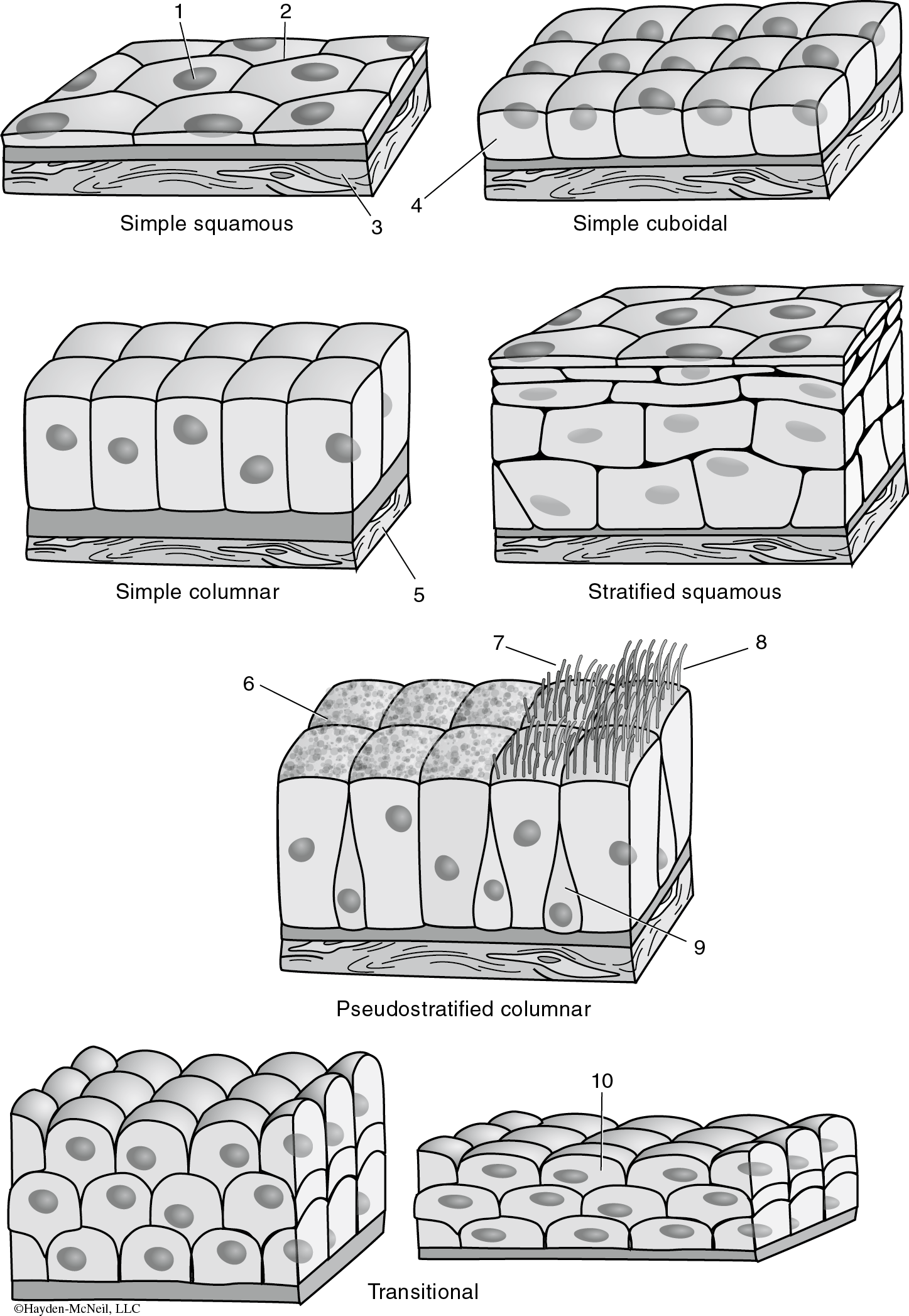
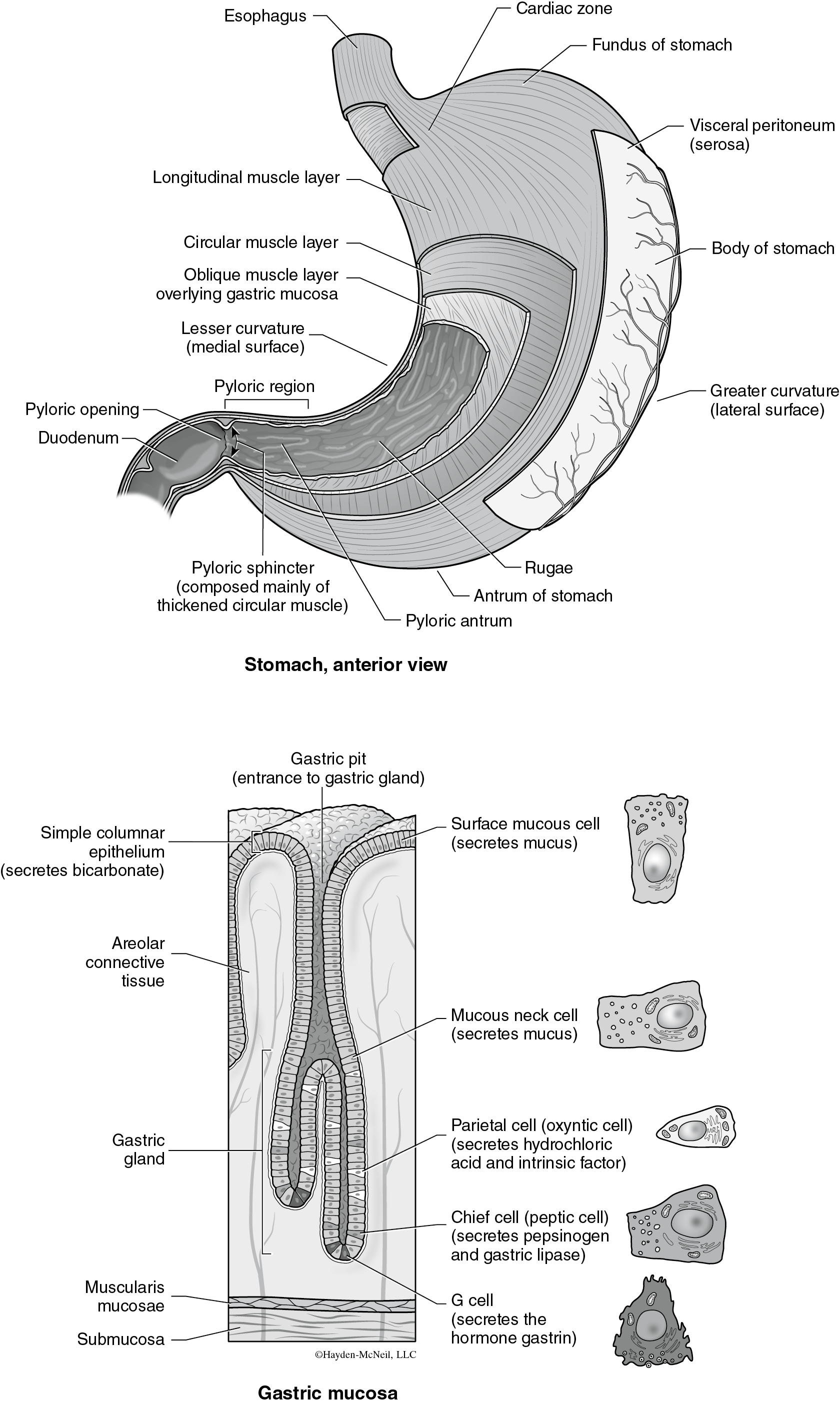



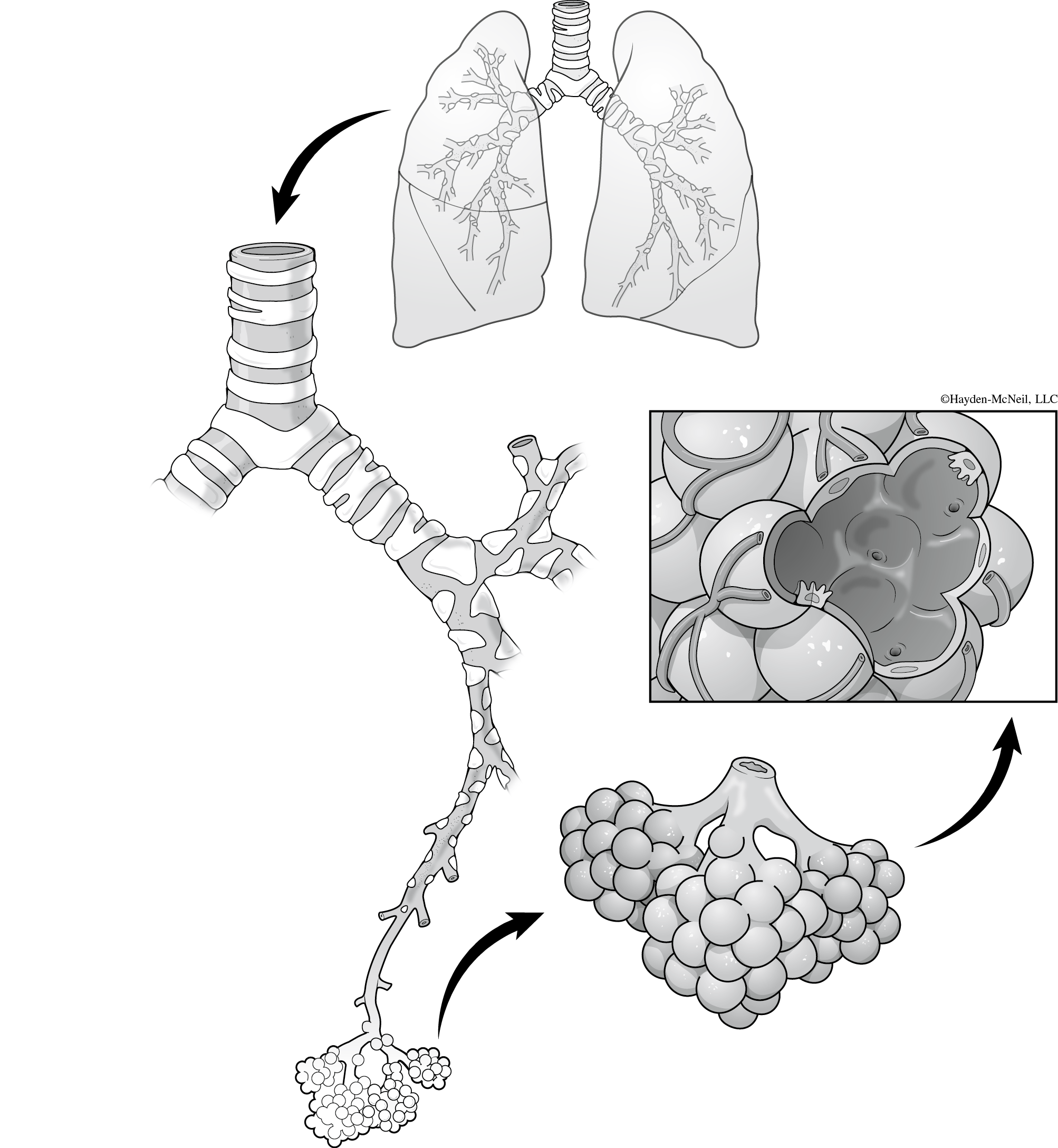
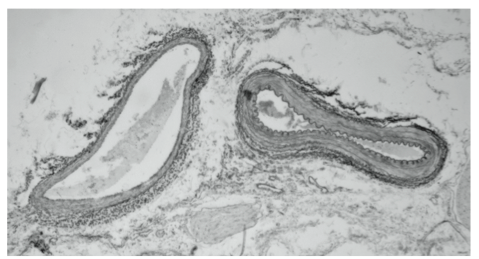
Rodent Dissection
3. Rodent Dissection
In Lab 6, you will investigate major organ systems of the rat as a representative of mammals. Almost all of the structures that you will see during this lab are also found in humans. By studying the anatomy of each system separately, you will learn how it contributes to the physiological function of the entire mammalian machine.
Resources
External Anatomy: http://www.biologycorner.com/bio3/anatomy/rat_external.html
Thoracic and Abdominal region: http://www.biologycorner.com/bio3/anatomy/rat_head.html
Urogenital Region: http://www.biologycorner.com/bio3/anatomy/rat_urogenital.html
Circulatory System: http://www.biologycorner.com/bio3/anatomy/rat_circulatory.html
Materials
Rats: one for every two students; preferably one male and one female per lab group
Models of human heart, human circulatory system, human and rat skeleton, and human digestive system
Paper towels
String
Anti-bacterial soap
NOTE: Text terms in bold are to be identified in either the rat, on slides under the light microscope, on photographs, or on micrographs. Questions that are italicized should be answered in your lab notebook.
Anatomy of Major Organ Systems
Procedure
Get two dissection pans and two rats per group, preferably one male and one female. Make sure you know how to identify sexes in the rat from the external anatomy.
- Before cutting, identify the following: head, eyes, eyelids, nares, ears, tail, mammary papilla, urinary orifice, scrotum containing testes (in males), the prepuce bulges around the end of the penis, the vaginal orifice in a depressed region called the vulva (in females), and anus.
- Following the dashed lines on the incision diagram, make one shallow incision directly down the midline of the rat from the chin to the base of the abdomen. Organs lie just below the skin, muscle, and ribcage, so be careful to avoid puncturing these organs.
- Make two additional incisions along the base of the abdomen towards the legs of the rat.
- In cutting through the skin in the thoracic (chest) region you will have to cut through the sternum (breastbone). Do so now using the scissors, but BE CAREFUL. Just beneath the rostral end (towards the nose) of the sternum are the major blood vessels that enter and exit the heart. When making this and other cuts with scissors, remember to lift the tips of the blades up as far as possible to prevent damage to the structures underneath it.
- Remove the membrane of connective tissue surrounding the organ cavities and pry back the ribs so you can see the internal organs. Make two additional lateral incisions under the forelegs of the rat, if necessary, to make this easier.
- Identify the bold structures in the steps below. Remember to answer the questions in your lab notebook.
Throat Region

Clear away the connective tissue in the throat region to see the thymus and the thyroid glands. The thymus gland is large in young animals and can be found both in this region and also in the thoracic cavity, surrounding the heart. You may remove this material, but note the characteristically "grainy" texture that helps identify it as gland rather than connective tissue.
The thyroid is the small, dark, symmetrical organ in the midline of the rat’s neck. Directly dorsal to the thyroid is the trachea. Without removing the thyroid, note the ringed cartilage that prevents collapse of the trachea during inspiration (it resembles the hose of a vacuum cleaner). Trace the trachea anteriorly to the larynx. Gently push the thyroid and the trachea to one side and locate the esophagus, which is dorsal to the trachea. What differences do you see between the esophagus and the trachea? How does this relate to function?
The large vessels near the surface of the neck are the jugular veins. Dorsal, and slightly medial to these veins, and lateral to the trachea, are the internal and external carotid arteries. Immediately adjacent to the carotid arteries is the vagus nerve. Note that the jugular veins, carotid arteries and vagi are all bilateral structures. Examine the “artery & vein cross section” slide. Then, cut a small piece of both the carotid artery and jugular vein from your rat. Compare the structures.
Thoracic (Figure D.11) Cavity
Tissues throughout the body metabolize glucose and oxygen (O2) and produce carbon dioxide (CO2) as waste. Large, multicellular organisms require a cardiovascular system which delivers O2 and glucose to the tissues via arteries and removes CO2 via veins. This is why highly metabolic tissues, such as muscle and nervous tissue are highly vacularized.
Cardiovascular System

The mammalian cardiovascular system consists of the heart (Figure D.12) and two circuits of blood vessels: 1) the pulmonary circuit includes the blood vessels that carry blood to and from the lungs and 2) the systemic circuit includes the blood vessels that carry blood to and from the rest of the body. Find the heart in the thorax. From the outside it appears to have two parts: a top part with blood vessels and a bottom triangular part. The dark flaps on the top, and on either side of the pulmonary artery and aorta, are the left and right atria; the bottom part contains the left and right ventricles.
Note: whenever we describe a left and right, we are referring to the rat’s left and right. If your rat is on its back (as it should be), then the left atrium and left ventricle will be on the right side of the heart, etc.
Examine the model of the heart and trace the flow of blood from the vena cava through the right side of the heart to the pulmonary artery. Then trace the blood from the pulmonary vein to the left side of the heart to the aorta. Note the valves that prevent the backflow of blood in the heart.
Dorsal to the heart, find the vena cava that carries oxygen poor blood from the tissues to the right atrium. Then blood goes to the right ventricle, the pulmonary artery, and the lungs where it is oxygenated.
Locate the aorta that curves rostrally, dorsally, and then caudally toward the abdomen. Follow the aorta down into the abdomen, noting the arteries that branch off from it to the major abdominal organs, including the celiac, mesenteric, and renal arteries. Nestled between the aorta and the vena cava on the dorsal side of the heart (the side closest to the spine) are the branch points from the pulmonary artery and vein. The large dark purple structure on the dorsal side of the heart is the merger of the cranial and caudal vena cava. The pulmonary artery and vein are dorsal to this structure.
Pulmonary System
As you were dissecting the throat region (Figure D.11), you identified the trachea (commonly called the windpipe). Open the rat’s mouth and try to locate the opening to the trachea. It is probably blocked by a small flap of skin called the epiglottis. Based on the anatomical position of the epiglottis, what is its function?
Surrounding the heart on either side are lobes of the lungs. Locate the muscular “wall” that divides the thorax from the abdomen. This is the diaphragm, which is skeletal muscle. A rat breathes much like you do. During inspiration, or breathing in, the diaphragm contracts; this increases the internal volume of the thorax and pushes the chest wall outward. This increase of volume results in a decrease of pressure (compared to the outside of the body). Air passively moves from higher pressure (outside of the body) to lower pressure (inside of the lungs) and a gas pressure equilibrium is reached UNTIL the diaphragm relaxes. Then the chest wall recoils into its original resting position (before you took a breath) and now the pressure on the inside of the lungs is greater than the outside the body. So air moves passively from higher pressure (inside of the lungs) to lower pressure (outside of body) and equilibrium occurs...until you want to breathe again!
Examine the slide of lung tissue. The many open spaces are the alveoli where gas exchange occurs. Locate the small capillaries and blood vessels in the lung tissue. Also, in most slides of the lung, you will be able to locate a bronchiole, which is the last branch of the lung airway before the alveoli. A bronchiole is surrounded by smooth muscle but does not have cartilage.
Gastrointestinal (GI) Tract
Unlike plants which are autotrophic, animals must ingest food in order to survive. After ingestion, the GI tract must digest macromolecules, absorb nutrients, and egest (eliminate unused food). The GI tract is a long assembly line of processes that normally involve the secretion of special enzymes by glands such as the salivary glands, stomach, pancreas, etc. In this portion of the laboratory, you will examine the structure of the digestive system and learn its anatomy.
The GI tract is a tube that begins in the mouth and ends at the anus. The inside of the GI tract is, in effect, the outside of the body. So, all materials absorbed from food and liquids must pass through the wall of the tract to enter the body. Food in the mammalian tract is digested mechanically and chemically. Chewing by the teeth in the mouth is purely mechanical and breaks the food into smaller particles, which increase the surface area on which digestive enzymes can act. Masticated food forms a bolus that the tongue helps you swallow. As the bolus passes through the pharynx, the epiglottis folds over the trachea so that the bolus can pass into the esophagus. The food moves caudally within the esophagus into the stomach. Notice that the esophagus passes through the diaphragm and thus is an organ that is found in both the thoracic and abdominal cavities.
Now that we have reached the abdominal cavity (Figure D.13), it may be necessary to remove part of the large dark purple structure that is taking up most of the space in the rostral abdomen, the liver. The liver must be lifted out of the way so that you can see the stomach. As you do this, notice another dark purple organ in this region on the left side the stomach, the spleen.
The stomach has a muscular wall and contraction of this wall mixes the food and enzymes. Epithelial cells in the stomach secrete hydrochloric acid (HCl), which lowers the pH (acid) of the stomach contents. HCl also stimulates the release of pepsinogen, a zymogen (an inactive proenzyme) that is converted to the active enzyme, pepsin. Pepsin is a protease that digests protein. The stomach then empties into the first section of the small intestine, called the duodenum.
Accessory glands of the duodenum release digestive fluids and enzymes which mix with the food. The liver produces bile salts, which are stored in the gall bladder. The cystic duct carries the bile to the common duct where it joins with pancreatic enzymes and ultimately is excreted into the duodenum where it mixes with food. Sometimes, bile salts precipitate and form stone-like objects called gallstones which cause painful irritations and affect one’s ability to digest fats. Locate the pancreas in the bend of the duodenum caudal to the stomach. The pancreas is an exocrine gland that releases digestive enzymes into the GI tract (“outside of the body”). The pancreas is also an endocrine gland which releases hormones such as insulin and glucagon into the cardiovascular system.

The small intestine is long (if you have time at the end of lab, pull it out and try to measure its length). This is where the majority of nutrient and water absorption takes place. Look at a slide of the small intestine under the microscope. Note that the lining has many folds. This folding increases the surface area for greater food absorption. Also notice that the intestines are surrounded by mesentery, a clear sheet of tissue that attaches them to the dorsal wall of the abdomen. Mesentery is a two layered membrane of mesothelium and connective tissue that support the blood vessels, lymphatic vessels and nervous tissue of the intestines.
Find the junction where the small intestine empties into the colon. (The colon is much shorter than the small intestine, but is larger in diameter, which is why it is often called the large intestine.) At this junction, the food must make a hairpin curve through a cul-de-sac like structure that is called a caecum. In many herbivores, this sac is large and contains organisms that secrete the enzyme cellulase, which then digests cellulose. In humans, our appendix is the vestigial remnant of this structure. The colon is responsible for the absorption of water left after digestion and food absorption in the stomach and small intestine. It is also used for storage of the waste material. The colon ends at the anus. Note the sphincter that prevents the emptying of the colon except during the process of defecation.
Renal and Reproductive Systems (Figure D.14)
Sometimes called the excretory system, the renal system is responsible for the removal of metabolic waste. The kidneys are the primary organ of this system and they filter the blood to form urine, which contains excess water, ions such as sodium, and waste products like urea. Kidney failure rapidly leads to death. Explain. The renal system also maintains a homeostatic balance of proteins, sugars, and some hormones. Push the intestines to one side so you can see the paired kidneys, and carefully cut away some of the connective tissue so you can trace the ureters which carry urine from the kidneys to the bladder, located ventrally between the umbilical arteries. Urine is stored here, and then released through the urethra to the outside in the female, or through the urethra and penis to the outside in the male.

What is the advantage of having a bladder? Find the renal artery and renal vein. Very carefully dissect away some of this connective tissue to find the adrenal gland attached to the rostromedial surface of the kidney. Use special care, because it is easy to discard the very small pink gland with the connective tissue.
The ovaries in the female are small kidney-shaped organs within the abdominal cavity just caudal to the kidneys. They are closely associated with tubes called the horns of the uterus (the equivalent of the fallopian tubes in humans). These tubes join centrally at the body of the uterus. Follow the uterus down to the vagina (you must cut the ventral pubic bone), where it joins the urethra and exits the body, just ventral to the colon and anus. (Note that in humans, the vagina and the urethra do not join, but have separate openings to the body surface, between the labia.) Make a longitudinal cut through the uterus and vagina.
In males, note the scrotal sacs on the exterior. In order to find the testes, you will have to locate the two ductus deferens: tubes which join just dorsally to the caudal end of the bladder, which you can trace back to the abdominal wall. The inguinal canal is a small “tunnel” in the abdominal wall that was formed by the descent of the testes, through which the spermatic cord, which also carries the spermatic artery and nerve, descend to the scrotum.
Cut through the abdominal wall in this area on one side only, and continue to cut through the skin of the scrotal sacs until you find the testis. Note the gubernaculum, which attaches the testes to the scrotal sac, and the epididymis, which runs along the side of the testis to the ductus deferens. Sperm are formed in the seminiferous tubules within the testis, and then move to the epididymis, where they mature and are stored until ejaculation through the ductus deferens. Follow the ductus deferens back rostrally to the urethra. Just dorsally, where they enter the urethra, are small paired glands, the seminal vesicles. The prostate gland is located between the seminal vesicles, but in the rat it is quite small it is extremely difficult to find. Now trace the urethra caudally towards the anus. Located on either side are the paired bulbourethral glands (Cowper’s glands, in humans). All these glands secrete the liquid, called seminal fluid, which carries the sperm.
Skeletal Systems Comparison
4. Skeletal Systems Comparison
The human (Figure D.15) and the rat (Figure D.16) skeleton are shown in diagrams below.
- Compare their similarities and differences.
- What modifications have been made to the human skeleton so we are capable of bipedal locomotion?
- Manipulate the bones on the limbs of the human skeleton. Notice the direction(s) the joints can move in. Where must muscles be attached to make these bones move?


Dissecting a Bony Fish
5. Dissecting a Bony Fish
External Anatomy (Figure D.17)
- Obtain a bony fish and place it on a dissecting tray.
- Identify the dorsal fins, the caudal fin (tail), the anal fin, and the paired pectoral and pelvic fins. Just anterior to the anal fin, locate the anus and urogenital opening, through which wastes are eliminated. Find the nostrils and eyes; note the absence of eyelids.
- Identify the opercula (gill covers), which play an important role in pumping water across the gills for gas exchange. Lift an operculum to reveal the gills underneath. Note the lateral line running along the side of the body. The lateral line system is used to sense changes in water pressure and water chemistry.

Internal Anatomy (Figure D.18)
- Place the fish on its right side: insert your dissecting scissors at the anterior base of the anal fin and cut forward along the mid-ventral line to the pectoral fins. Make a second cut parallel to the first, but above the lateral line. Now connect the two cuts with vertical cuts at each end and remove the left body wall. Cover open fish with water before continuing!
- The swim bladder (or air bladder) is a large thin-walled air sac dorsal to the other organs. By moving gases (O2, N2, CO2) between the blood and the swim bladder, the fish is able to adjust its buoyancy, enabling it to hover nearly motionless at a wide range of depths (surrounding water pressure varies with depth). Some fish can actually fill the swim bladder by gulping air. The swim bladder may function not only to regulate buoyancy, but also in respiration or sound production. It may also serve as a sense organ. Many biologists believe the swim bladder is homologous to the lung of tetrapods (terrestrial vertebrates). In this evolutionary sense, homologous structures have evolved from the same structure in some common evolutionary ancestor during the course of vertebrate evolution.
- Examine the digestive system. Using a probe, trace a path from the mouth through the pharynx (note the gill slits on each side) and esophagus to the stomach. Pouch-like digestive caeca may be attached to the stomach. Food is stored and processed in the stomach, then passed into the intestine for further processing and absorption. Wastes are eliminated through the anus.
- Find the small spleen, located between the stomach and intestine (the spleen is not part of the digestive system; it plays a role in the production and breakdown of blood cells). The liver is a large, lobed organ that secretes bile, which helps digest fats by acting as an emulsifier, like a detergent. The liver also has an important role in storing carbohydrates and fats and in regulating various aspects of blood chemistry. Underneath the lobes of the liver is the dark green gall bladder, which stores bile produced by the liver and passes it into the intestine through the bile duct.
- The heart is located anterior to the liver. It is composed of two chambers, a posterior atrium and an anterior ventricle.
- Locate the long dark kidneys, dorsal to the swim bladder. Liquid nitrogenous wastes (ammonia and urea) are removed from the blood in the kidneys and carried to the urinary bladder to be expelled through the urogenital aperture. These structures may be hard to see. Finally, identify the gonads (paired testes in males, a single large ovary in females), which release gametes to the outside through the urogenital aperture.
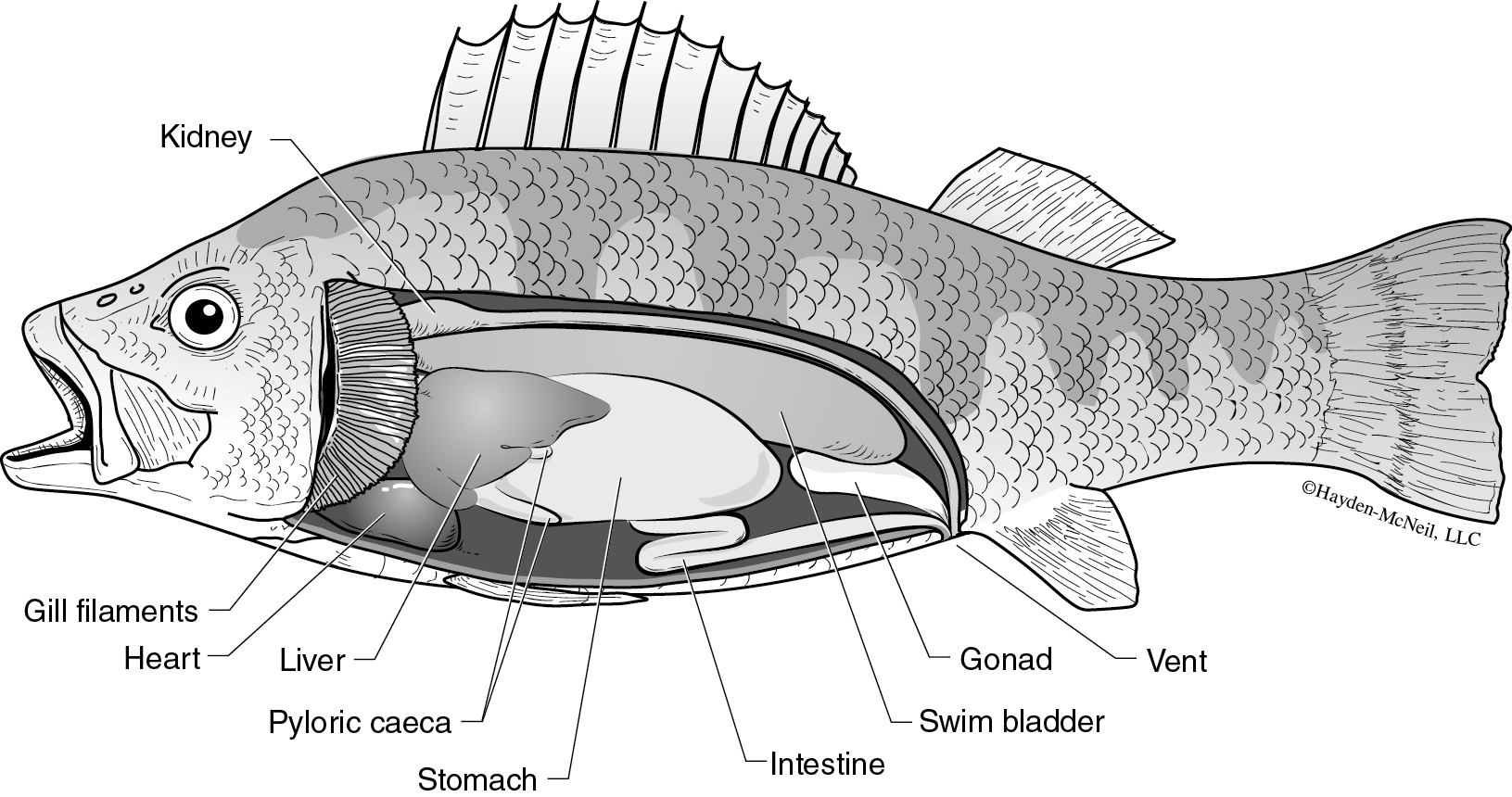
Clam Dissection
6. Clam Dissection
When most people think of bivalves, they think of dinner! Clams, oysters and mussels are a global delicacy. Snails, squid and octopus are also mollusks and like the bivalves above, some are also highly prized as food. How can such different looking animals belong to the same taxonomic group? Though their shapes are profoundly different they share features that allow us to place them together. The name mollusk means “soft-bodied” but all mollusks are bilaterally symmetrical, have a reduced coelom, have an open circulatory system called the “hemocoel”, they mostly concentrate their organs in a visceral mass, their bodies are covered with a protective tissue called a mantle, their heart has an auricle and ventricle, their mouth often has a radula, and early development in the mollusks is the same. As you do this clam dissec- tion, think about reasons why pearls are formed when sand or other particles get caught between the shell and the mantle. Also, consider the adaptations a bivalve needs if it has to burrow very deeply.
Procedure
- Obtain a clam (Figure D.19) and place it on your dissecting tray. The clam’s shell is composed of two valves hinged together on their dorsal side. Note the umbo on the dorsal region each of these valves. This is the oldest part of the shell, and concentric growth lines that form around it can be used to age the organism. The calcium carbonate shell is covered with a thin proteinaceous periostracum.
- Two large muscles, the anterior and posterior adductor muscles, hold the shell valves together. When they relax, the valves open. Locate the positions of the adductor muscles, then carefully insert a scalpel blade between the valves and slice through the muscles along the inside of the left valve, trying to avoid damaging both the clam’s internal organs and yourself.
- Open the clam and remove the left valve by twisting the upper valve to break the hinge ligament. Free the mantle from the inside of the left valve. Completely cover the specimen with water before continuing with dissection and observations. Note that the mantle edge has three folds that perform three functions: the inner fold contains muscle, the middle fold is sensory, and the outer fold secretes the shell.
- At the posterior end of the clam, locate the incurrent siphon and, just dorsal to it, the excurrent siphon. The siphons are used to take in and expel water.
- Carefully cut away the left mantle, exposing the mantle cavity. Identify the foot, which extends anteriorly from the visceral mass. Locate the large, flaplike gills, or ctenidia. Remove the ctenidia to expose the visceral mass, which encloses most of the internal organs. Find the labial palps, which surround the mouth.
